If you are worried when your new baby will cry, you are not able to have a meal at a restaurant in peace, you might want to consider buying the best Pacifier for your breastfeeding baby. Pacifiers also known as dummy meets the baby’s need, they have a natural need to suck. From newborn to toddler pacifier has a little bit of comfort for every baby’s needs.
Naturally, babies have a strong sucking reflex. They even suck their thumbs or fingers. Science says that sucking often has a soothing, calming effect. There are so many strong opinions about using a pacifier, though it’s a personal decision. Some babies take a pacifier without any problems, while others will get annoyed. You will know about your child best, and determine if using a pacifier is right for your baby. You can also consult with a doctor to help you. It is artificial so some good things pacifier does but there are lots of risks also.
What is a Pacifier?
A piece of soft silicone or latex as nipple shaped. The baby holds the silicone and puts it on the front part of their tongue. This makes for an easy transition from breast to pacifier. It gives security or comfort to the baby. It has some cute nicknames including soothers, dummies, and binkies.
Types of Pacifiers
You’ll find a wide variety of colors, designs, and nipple shapes in the pacifier. Be sure about the size, choose large one so that your baby can’t put the entire pacifier into the mouth. The shield should have ventilation holes. Basically pacifier are two types: one is orthodontic and another is non-orthodontic.
Orthodontic: It designed like a mother’s nipple shape which has a round top and a flat bottom. The nipple tip is square-shaped. It ensures that your baby’s stop and bottom jaw are in the correct position when the pacifier put in their mouth.
Non-orthodontic: The pacifier is older with bulb shape. Parents usually don’t want to choose nowadays.
How to Choose the Best Pacifier For Breastfeeding Baby
Size: The size of a pacifier is really important to consider. Select that match it to your baby’s age. You will find a variety of nipple shapes. Take to select different because you don’t know what will be fond of your baby.
Construction Quality: Choose the pacifiers that are free of bisphenol-A (BPA), which may be toxic. Give your baby silicone pacifiers, which are less likely to pose a choking hazard. Latex is technically referred to as natural rubber.
Nipple Material: It is an artificial nipple. There are three parts the nipple; the guard, and the ring. It is usually of latex or silicone.
Washable: You can pop the pacifier in the dishwasher. You can clean it using hot water and soap, it is a quick option. Sterilizing is a good idea, drop it into a pot of boiling water for five minutes to sterilize it.
10 Best Pacifiers For Breastfeeding Baby
1. WubbaNub Infant Pacifier – Giraffe
The pacifier is functional and stylish with Animal combination. Your baby will love it for a unique style. Wubbanub is made of a medical-grade silicone pacifier, not only home also used in hospital, completely safely tested and highly recommended for newborn baby through six months.
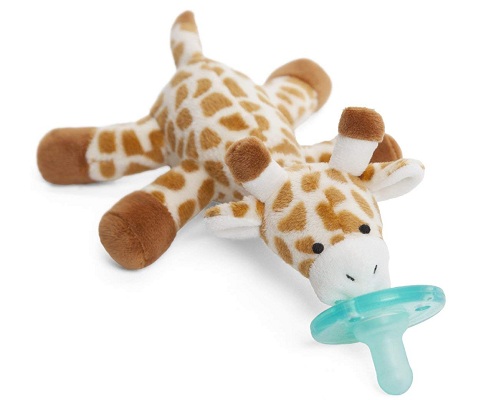

- Unique style
- Assist baby to self-sooth
- Completely safety tested.
- With Animal combination
- Latex-free, BPA, PVC and Phthalate free
- Not suggested for babies with teeth or in the teething stage
- The giraffe is very light.
- Price is comparatively high.
2. MAM Night Pacifiers 0-6 Months
The pacifier is designed to keep baby calm and also assist in oral development. It has a skin-soft nipple that is easily accepted by babies. These pacifiers are totally soft silicone that is clear, tasteless, odorless and durable. It glows in dark that’s why parents and babies easily can find in the night.
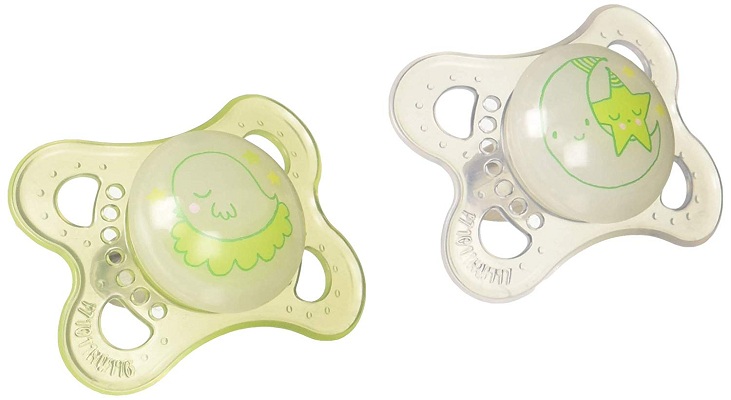

- Larger shield
- Glows in the dark
- Ensure the proper development of baby’s palate, teeth, and gums
- Is made of skin-soft silicone
- Only for newborn baby
- A few parents don’t like it for shape, it is too curved.
3. Tommee Tippee Everday Pacifier, Bottle Shaped Nipple, 0-6 Months
It is BPA-Free, The shape of this is the bottle’s nipple. Baby can use it up to 6 months, even newborn baby also. The design may vary sometimes, it is traditionally shield designed so that ideal for newborn baby because the shape gives support for natural oral development.


- Nipple is reversible so that it easier for babies to correctly insert
- It is easy to use and baby will definitely love it.
- They are similar to the shape of mom
- The outside of these pacifiers is hard plastic
- Nipple is too soft.
- Traditional shield
4. Dr. Brown’s Pacidose Pacifier Baby Medicine Dispenser with Oral Syringe-6-18 Months
Pacidose is a baby medicine syringe with a soft pacifier-like nipple. This product is amazing, Invented by a doctor, this is made in 3 different sizes to ensure you select the right size which matches your child’s age. You can give 1 ml or 10 ml of medicine to your child by this syringe.
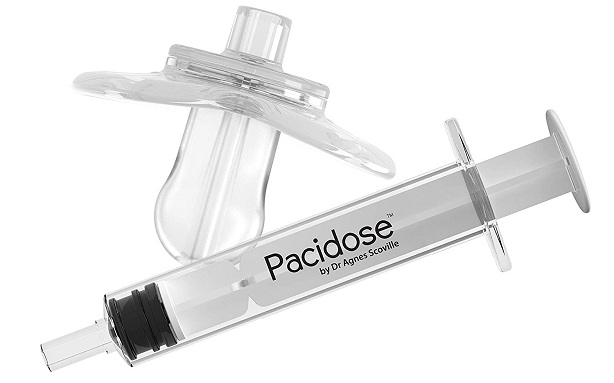

- Baby takes medicine via a syringe.
- Soft pacifier as like nipple
- Used in homes and hospitals both
- Pacidoseis more baby-friendly
- Hard oral Syringe
- Size does matter so many people get confused by the size.
5. Philips Avent Soothie Pacifier, 3+ Months
Philips Avent pacifier helps to calm and soothe babies. It is designed for babies 3 months and older. The Soothie pacifier is made of hospital-grade, comfortable and durable. It is specially sized and shaped for baby’s mouth.
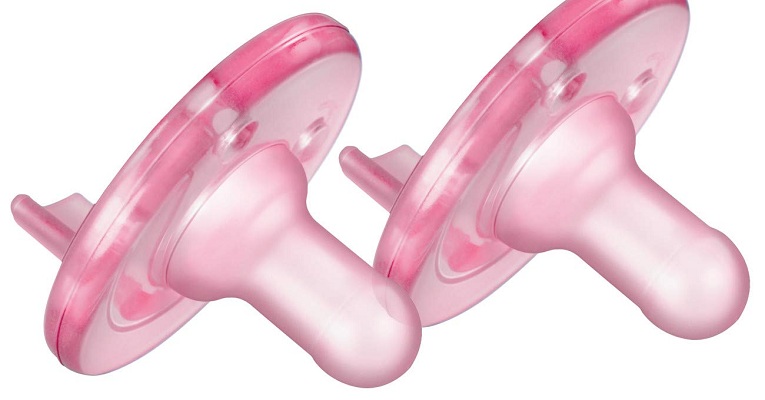

- BPA-free and latex-free silicone
- Transparent, tasteless and odorless
- Nipple is strong and smooth
- Do not hinder oral development
- The nipple is a bit smaller and shorter
6. Chicco PhysioForma 100% Soft Silicone Pacifier for Babies 0-6 Months
These pacifiers are designed to help position the baby’s tongue, actively support the baby’s breathing, clinically, tested and approved by an advisory panel of leading neonatologists, pediatricians, and orthodontists. It Supports the development of palate and teeth also.
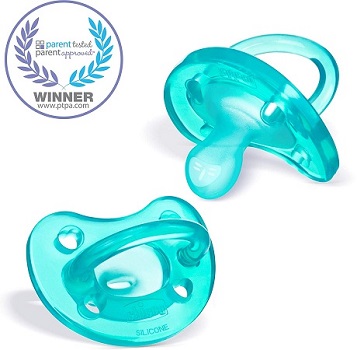

- Nipple shape helps for proper tongue placement
- 100% silicone
- BPA and LATEX Free
- Prevent the gathering of saliva
- Nipple was designed exclusively.
- The shield is hard
- The 6+ Chicco is too large
7. NUK Orthodontic Pacifiers, Boy, 6-18 Months
The NUK pacifiers are accepted by 95% of babies with super-cute Designs. The nipple of the pacifier naturally fits the baby’s palate, reduces pressure on teeth and jaw, and helps prevent teeth misalignment. It was invented over 60 years ago by pediatric dentists. It is ideal for your child aged 6-18 months.


- Heart-shaped shield fits baby’s nose for easy breathing
- BPA-free; silicone nipples
- You can easily clean pacifiers in microwave
- Designed with the natural shape of mom’s nipple
- Sometimes larger size doesn’t available.
- Not applicable for newborn baby
8. WubbaNub Elephant Pacifier
WubbanubPacifier is very stylish with an elephant version and babies will love it. It is easy to grasp in baby’s mouth. The pacifier is made with medical-grade silicone pacifier. You can sanitize it with warm soapy water. Perfect for newborn baby through six months.
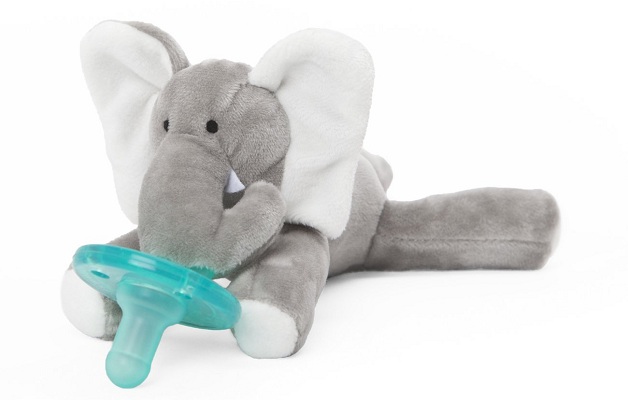

- It easy for baby to grasp
- Latex-free, BPA, PVC and Phthalate free
- It is made with a medical-grade silicone pacifier
- A few babies don’t like the animal combinations.
- There is no large size
9. Dr. Brown’s HappyPaci 100% Silicone Pacifier
This product is a soft silicone pacifier shaped like Dr. Brown’s bottle nipple. If you want to introduce it to your baby then the baby will grab it because of the lightweight and 100% silicone. The features a contoured butterfly-shaped shield that curves away from the baby’s face for comfort.
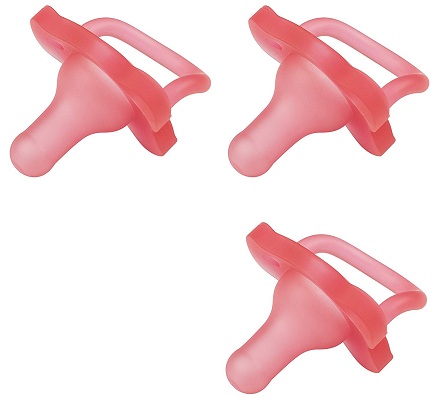

- Mom will love the One-piece construction
- 100% silicone
- Contoured “butterfly”-shaped shield
- It has a round edge this is troubling with tiny babies.
- Baby can easily throw because of super lightness.
10. NUK Sensitive Orthodontic Pacifiers
It is smoothly designed with 100% silicon, contours to baby’s face, preventing marks on their sensitive skin. NUK pacifier is modeled after the natural shape of mom’s nipple with a heart-shaped shield. It is easier for the baby’s breathing and prevents irritation.
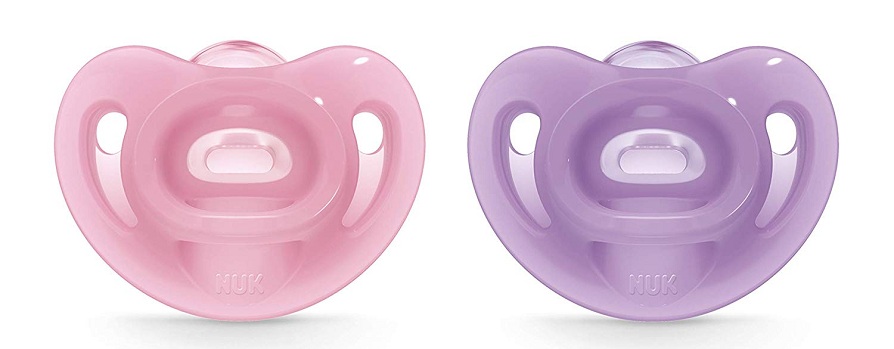

- 100% silicone design
- Preventing marks on their sensitive skin
- Heart-shaped shield
- BPA-free
- Some parents say that size is not perfect
- Perfect only for newborn babies.
- Designed only for a boy
Important Things to Consider Before Giving a Pacifier to Your Breastfed Baby
Introducing the pacifier when: If your baby has a strong sucking reflex you can give pacifier but Wait until your baby is three to four weeks when the baby will be well established in breastfeeding. New mothers often don’t understand the process. If baby wants the only pacifier then give it to him, will be calm down, but if they spit it out then your baby might be hungry.
When to stop: When your baby’s top or bottom front teeth may slant or tilt especially after age 4, which is when permanent teeth start to come in the best time to stop using a pacifier.
What: The most important things to consider are the materials and size to choose the right pacifier. You can use both silicone and latex, both options are fine, but comparatively, silicon are more famous because it is soft and flexible. Make sure that your pacifier is BPA free.
How: Some babies take the pacifier easily and they enjoy it a lot but others don’t like it and get annoyed with this it occurs when breastfeeding babies refuse to suckle on pacifiers.
You have to replace it depends on how often your child sucks it. Check the pacifier thoroughly before placing it in your baby’s mouth. Those aren’t very expensive, so it’s best to replace them early.
How to Use Pacifier
Pacifiers help parents in those in the early months. Physicians are asked for proper guidance about pacifier use by parents. Before offering a pacifier, you have considered some rules that are mentioned below.
Using Rules
- Make sure the pacifier is cleaned. For an infant, the pacifier needs to boil before use, for 6 months baby you can simply wash pacifiers with soap and water.
- Replace the pacifier when it is damaged.
- Sometimes parents start struggling to give baby pacifier but you should not force your baby when your baby is not comfortable with pacifier.
- Don’t coat it with sugar or honey.
- Give appropriate size for your baby’s age.
- Dispose of the pacifier after use
- Wash pacifiers with soap daily
- Be sure it doesn’t replace mealtime
- Avoid Two-piece pacifiers.
- Follow the manufacturer’s instructions properly.
- Never tie anything with the pacifier.
- It should not be used for more than 3 months.
- Use caution with pacifier clips.
Advantages of Pacifier
Minimize the Risk of SIDS: studies have found that the using of a pacifier has been shown can prevent sudden infant death syndrome (SIDS). You may give your baby a pacifier while he’s asleep, it might lower the risk of SIDS. BASIS—Baby Sleep Information Source provides comprehensive discussions on this topic on media.
Suck Reflex: A Baby has a natural need for sucking in that case a pacifier can help for non-nutritive sucking, it is important to make a proper diagnosis of reflux and pacifier will help to diagnose.
Soothe: It can soothe a crying baby. Some babies are happy when they are sucking something. It makes them feel secure and relaxes during vaccinations, lab tests, or other medical procedures.
Learn to Use Bottle: For babies who learn to use bottles, pacifiers can help those.
Might Help to Baby Asleep: It will help to continue for nighttime sleep.
May Help Acid Reflux: It is important to make a proper diagnosis of reflux pacifier helps for acid reflux of baby.
Relief Stress: It gives a calming effect and relieves some stress.
Relieve Pain: Pacifiers are used to help relieve pain from minor procedures. The American Academy of Pediatrics states “Sucking can be a form of pain relief and if a breast isn’t available a pacifier can help provide pain relief through the procedure.
Premature Baby: Premature babies who are temporarily unable to breastfeed can help them to digest their food until breastfeeding can be established if using a pacifier helps to increase weight. Some newborns may find it easier and help also tube-fed babies learn for using a bottle.
Traveling: It is helpful during travel on an airplane; it can minimize the pressure in the middle ear.
For Sleeping Purpose: If your baby has trouble sleeping a pacifier might help your baby fall asleep or reducing or nighttime awakenings.
Disadvantages of Pacifier
Ear problem: Baby who uses pacifiers has a chance to get infected in-ear.
Tooth problem: Prolonged pacifier might cause a child’s teeth. It can affect the way baby teeth grow. Excessive use of pacifiers could affect tooth problems.
Crying: Some babies who use pacifiers start crying when the pacifier falls out of their mouths.
Missed hunger cues: Babies use some hunger cue when they are hungry like searching for the breast with a wide-open mouth. These signals are known for us. Using a pacifier can cause you to be missed these signals. Using pacifier during the day can hamper to get enough milk at daytime feedings
Baby becomes dependent: your baby uses a pacifier to sleep and depended on eating and sometimes it hampers for taking the meal.
Hardest to break: It is one of the hardest habits to break. Parents sometimes struggle with this. It will be difficult to give up because the baby may become overly attached to a pacifier.
Low milk supply: a mother’s milk supply might drop using a pacifier, there is a reason for this happening if the mother uses a pacifier for being in a shallow latch it means the breasts are emptied less well. When breasts are not emptied often enough then ultimately milk supply will get slow.
Frequently Ask Questions About Pacifiers For Breastfeeding Baby
Do All Babies Like Pacifiers?
Pacifier is totally artificial nipple. It is your decision when you wish to comfort the baby yourself or either pacifier. It is generally best to encourage breastfeeding. Some babies might also be allergic to the pacifier. Parents should concern if they see any potential acidic reaction. Few babies don’t like pacifiers, you have to look at their reaction before introducing to your baby.
What About Pacifiers and Nipple Confusion?
Nipple confusion occurs when a breastfeeding newborn is given a pacifier. They feel confused between the different feel, shape and sucking action. To remove the risk of confusion, parents should wait until breastfeeding is well established.
Are Silicone or Latex Pacifiers Better?
There was a choice between latex and silicone nipples. There are two sturdier in Silicone nipples. Those are soft and flexible and you can clean more easily. Silicone is good rather than latex pacifiers because your baby could have an allergy to latex.
Final Verdict
A parent may find it difficult to take the decision to give the baby pacifier whether or not. Parents should examine all information about pacifiers. We can say that pacifiers could earn some respect from new parents because it helps babies soothe themselves. It is absolutely easy, quick and simple but there is some potential disadvantage also. You need to know all about the pacifier.
